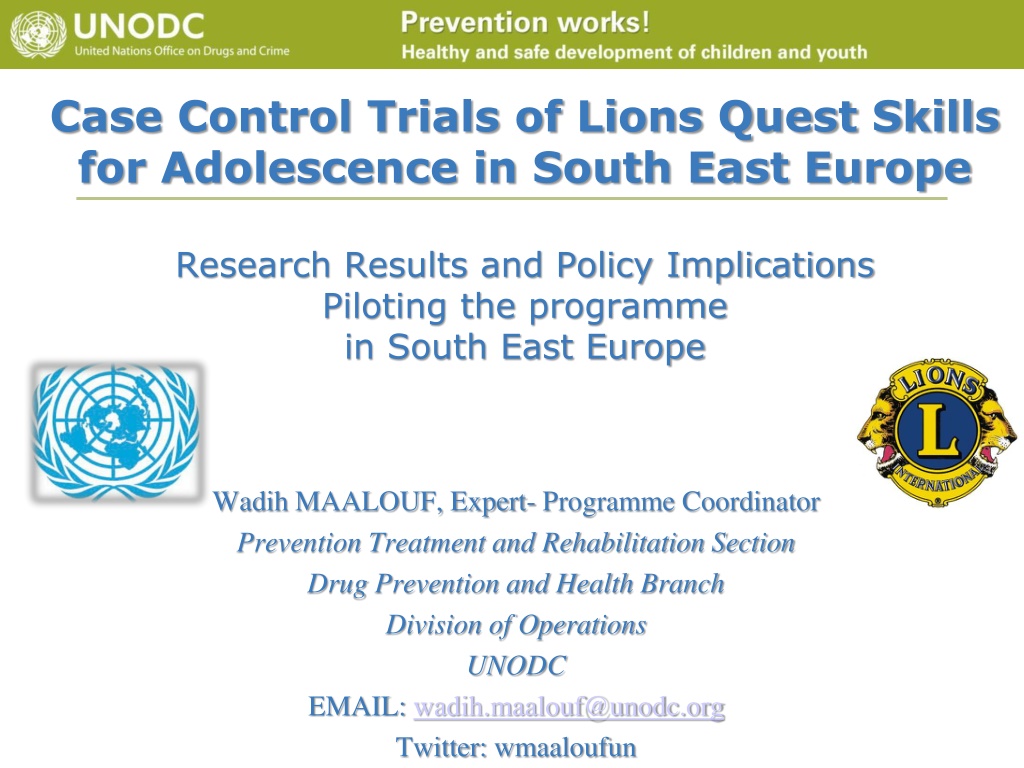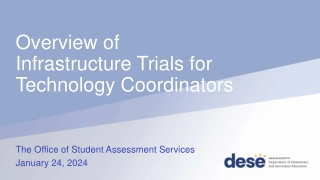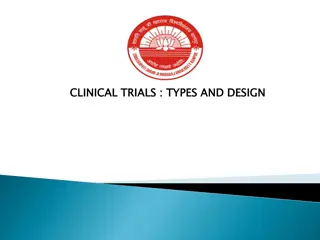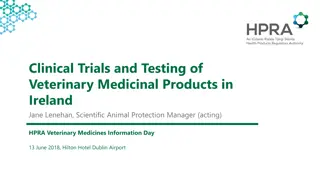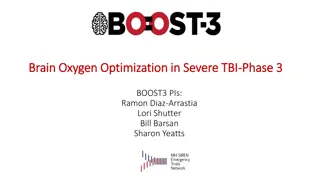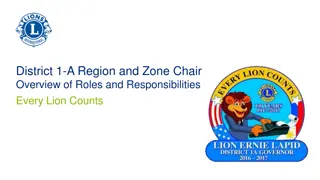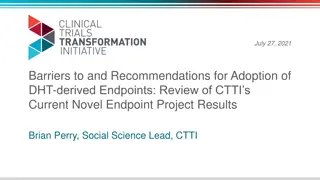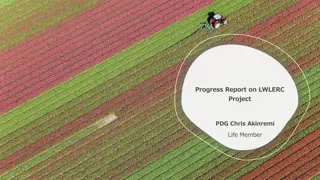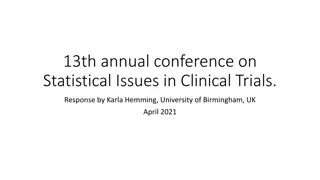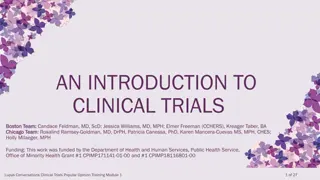Case-Control Trials of Lions Quest Skills in South East Europe Research Results
Research results from a study on the effectiveness of Lions Quest Skills program for adolescents in South East Europe, conducted by Wadih Maalouf, expert and programme coordinator at UNODC. The baseline demographics and current substance use data from Montenegro, FYRO Macedonia, and Serbia are presented, along with insights on intention to use substances in the next three months among current users.
Download Presentation

Please find below an Image/Link to download the presentation.
The content on the website is provided AS IS for your information and personal use only. It may not be sold, licensed, or shared on other websites without obtaining consent from the author. Download presentation by click this link. If you encounter any issues during the download, it is possible that the publisher has removed the file from their server.
E N D
Presentation Transcript
Case Control Trials of Lions Quest Skills for Adolescence in South East Europe Research Results and Policy Implications Piloting the programme in South East Europe Wadih MAALOUF, Expert- Programme Coordinator Prevention Treatment and Rehabilitation Section Drug Prevention and Health Branch Division of Operations UNODC EMAIL: wadih.maalouf@unodc.org Twitter: wmaaloufun
Baseline - Demographics Montenegro (N=1,572) INT FYRO Macedonia (N=1,575) INT Serbia (N=2,049) INT CONT p-val CONT p-val CONT p-val N (%) N (%) N (%) N (%) N (%) N (%) N=804 N=768 N=795 N=780 N=1,365 N=684 `Gender Males 418 (52%) 385 (50.1%) 386 (48.6%) 400 (51.3%) 668 (48.9%) 360 (52.6%) Females 386 (48%) 383 (49.9%) 0.46 409 (51.4%) 380 (48.7%) 0.28 697 (51.1%) 324 (47.4%) 0.11 Age Years <11 0 0 1 (0.1%) 0 5 (0.4%) 0 11 2 (0.3%) 3 (0.4%) 16 (2.1%) 11 (1.4%) 68 (5.3%) 13 (2%) 12 129 (17.2%) 158 (21.5%) 224 (28.6%) 207 (27.1%) 290 (22.6%) 105 (16.4%) 13 227 (30.2%) 253 (34.4%) 241 (30.8%) 243 (31.8%) 468 (36.5%) 294 (45.9%) 14 324 (43.1%) 260 (35.3%) 171 (21.9%) 168 (22%) 359 (28%) 199 (31%) 0.02 <0.01 >14 69 (9.2%) 62 (8.4%) 129 (16.6%) 135 (17.7%) 0.77 91 (7.1%) 30 (4.7%) Mean <0.01 0.02 13.4 (0.9) 13.3 (0.9) 13.3 (1.3) 13.4 (1.3) 0.40 13.1 (1.0) 13.2 (0.8) age (SD)
Baseline - Current substance Use Montenegro (N=1,572) FYRO Macedonia Serbia (N=2,049) (N=1,575) INT CONT p- INT CONT p- INT CONT p-val N (%) N (%) val N (%) N (%) val N (%) N (%) Drinking alcohol Never used 481 (60.1%) 212 (26.5%) 107 (13.4%) 487 (63.7%) 177 (23.1%) 101 (13.2%) 515 (64.5%) 185 (23.2%) 98 (12.3%) 493 (62.9%) 182 (23.2%) 109 (13.9%) 792 (58.2%) 373 (27.4%) 196 (14.4%) 425 (62.1%) 181 (26.5%) 78 (11.4%) Never last 30 days Users last 30 days Smoking cigarettes Never used Never last 30 days Users last 30 days Smoking marijuana Never used Never last 30 days Users last 30 days 0.28 0.62 0.11 745 (92.7%) 46 (5.7%) 13 (1.6%) 718 (93.7%) 36 (4.7%) 12 (1.6%) 721 (91.3%) 46 (5.8%) 23 (2.9%) 689 (88.2%) 62 (7.9%) 30 (3.8%) 1,259 (92.6%) 621 (92.4%) 65 (4.8%) 36 (2.7%) 30 (4.5%) 21 (3.1%) 0.83 0.14 0.79 788 (98.4%) 7 (0.9%) 6 (0.7%) 750 (98.4%) 5 (0.7%) 7 (0.9%) 779 (98.4%) 10 (1.3%) 3 (0.4%) 764 (97.8%) 14 (1.8%) 3 (0.4%) 1,329 (98.2%) 659 (98.1%) 10 (0.7%) 15 (1.1%) 7 (1%) 6 (0.9%) 0.83 0.69 0.71
Delta change current use of substances within group * <0.05; ** <0.01
Baseline Intention to use next 3 months in current users Montenegro (N=1,572) FYRO Macedonia Serbia (N=2,049) (N=1,575) INT CONT p- INT CONT p- INT CONT p-val N (%) N (%) val N (%) N (%) val N (%) N (%) Intention to drink alcohol No 682 (84.7%) Yes 123 (15.3%) Intention to smoke cigarettes No 778 (96.9%) Yes 25 (3.1%) Intention to smoke marijuana No 785 (97.8%) Yes 18 (2.2%) 670 (87.7%) 94 (12.3%) 680 (85.6%) 114 (14.4%) 666 (85%) 118 (15%) 1,171 (86.5%) 183 (13.5%) 575 (84.9%) 102 (15.1%) 0.09 0.7 0.34 745 (97.4%) 20 (2.6%) 764 (96.3%) 29 (3.7%) 764 (97.3%) 21 (2.7%) 1,294 (95.8%) 57 (4.2%) 657 (96.3%) 25 (3.7%) 0.55 0.27 0.55 751 (98.4%) 12 (1.6%) 785 (99.2%) 6 (0.8%) 769 (98.8%) 9 (1.2%) 1,315 (97.3%) 37 (2.7%) 666 (98.2%) 12 (1.8%) 0.33 0.42 0.18
Delta change Intention to use substances among current users within group * <0.05; ** <0.01
ANOVA analysis post-intervention outcome Montenegro FYRO Macedonia Serbia Substance use in the last 30 days* Study group INT CONT INT CONT INT CONT Substance use intention to use in the coming 3 months ** p value at t1 p value at t1 p value at t1 N at t1 101/738 121/732 25/740 34/731 12/736 33/731 t1 % 13.7 16.5 3.4 4.6 1.6 4.5 N at t1 130/736 151/730 18/736 40/728 5/736 14/727 t1 % 17.7 20.7 2.4 5.5 0.7 1.9 N at t1 209/1,188 216/1,060 55/1,187 56/1,048 37/1,183 26/1,044 t1 % 17.8 20.4 4.6 5.3 3.1 2.5 Alcohol 0.13 0.14 0.09 Cigarettes <0.01 0.21 0.44 Marijuana <0.01 0.03 0.37 INT CONT INT CONT INT CONT 111/739 130/731 32/738 42/729 14/736 28/726 15 17.8 4.3 5.8 1.9 3.9 141/734 154/729 13/736 36/727 13/733 16/727 19.2 21.1 1.8 4.9 1.8 2.2 234/1,188 238/1,056 74/1,178 88/1,054 47/1,173 38/1,050 19.7 22.5 6.3 8.3 4 3.6 Alcohol 0.15 0.36 0.10 Cigarettes <0.01 0.21 0.06 Marijuana 0.02 0.56 0.63
Transferability documenting positive effect (bottom-up success)! Impact on substance use initiation and intentions to use substances among users . Very encouraging. Relatively short follow up period. Replication across countries with similar cultures encouraging (despite first attempt in countries were scientific culture is not prominent).
Exploring effect on normative belief (estimates of friends and 7th graders use), perception of harm and refusal skills as well as gender differences (as much as possible). Process lead to no full implementation. Practicality of implementing in 1 academic year, need to stretch to 2 Difference of modality of implementation of the study in Serbia. Yet results still encouraging.
High affinity and motivation in countries due to absence of such programmes (despite original hesitation of MoE). Encourage government to dig in deeper in the data to look for sub-group analyses (moderators/interactions). Run further studies on scale up and process refinement. Expansion plans ongoing to benefit Albania and Bosnia- Herzegovina and Guatemala (2 year implementation)
Reviewer 2: The researchers are to be congratulated on their work on this substantial research project across three countries. This is exactly the sort of study that should be informing policy and practice and should be included in high level Cochrane systematic reviews of the effectiveness of school based alcohol prevention efforts. I particularly liked that the manuscript clearly describes the skills based orientation of the prevention curriculum, and notes that this is consistent with best evidence and practice identified in the latest international guidance from high level and well regarded organizations.
Colleagues Matthew Kiefer Milos Stojanovic, Bojan Milosavljevic Giovanna Campello, Hanna Heikkila Ziad Khatib Marianne Jannsson fredriksson Ministries of Education (Serbia, FYRO Macedonia, Montenegro) Teachers
Case Control Trials of Lions Quest Skills for Adolescence in South East Europe Research Results and Policy Implications Piloting the programme in South East Europe Wadih MAALOUF EMAIL: wadih.maalouf@unodc.org Twitter: wmaaloufun
